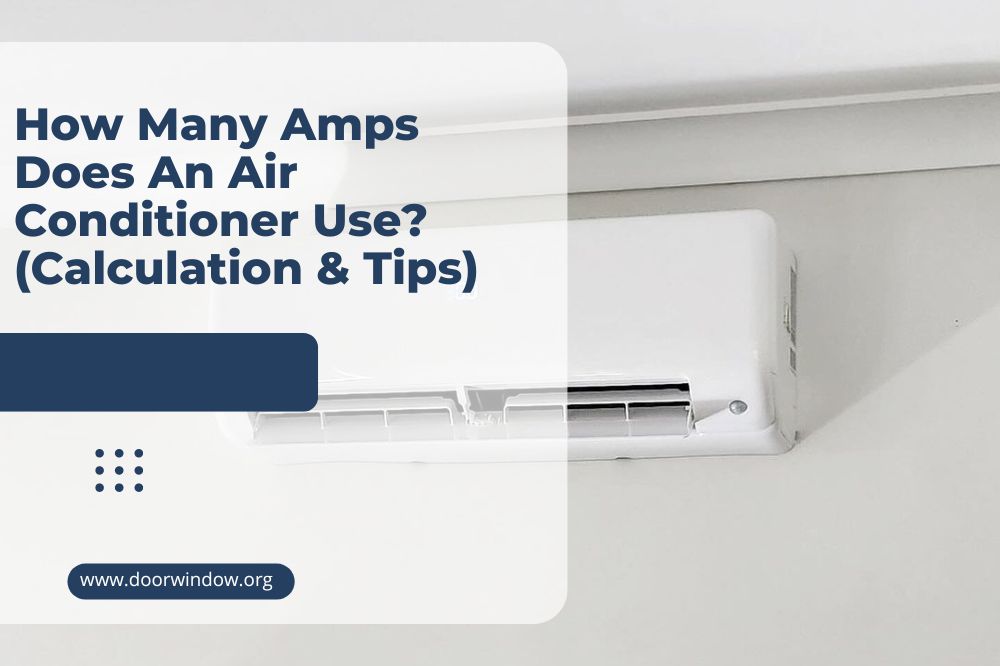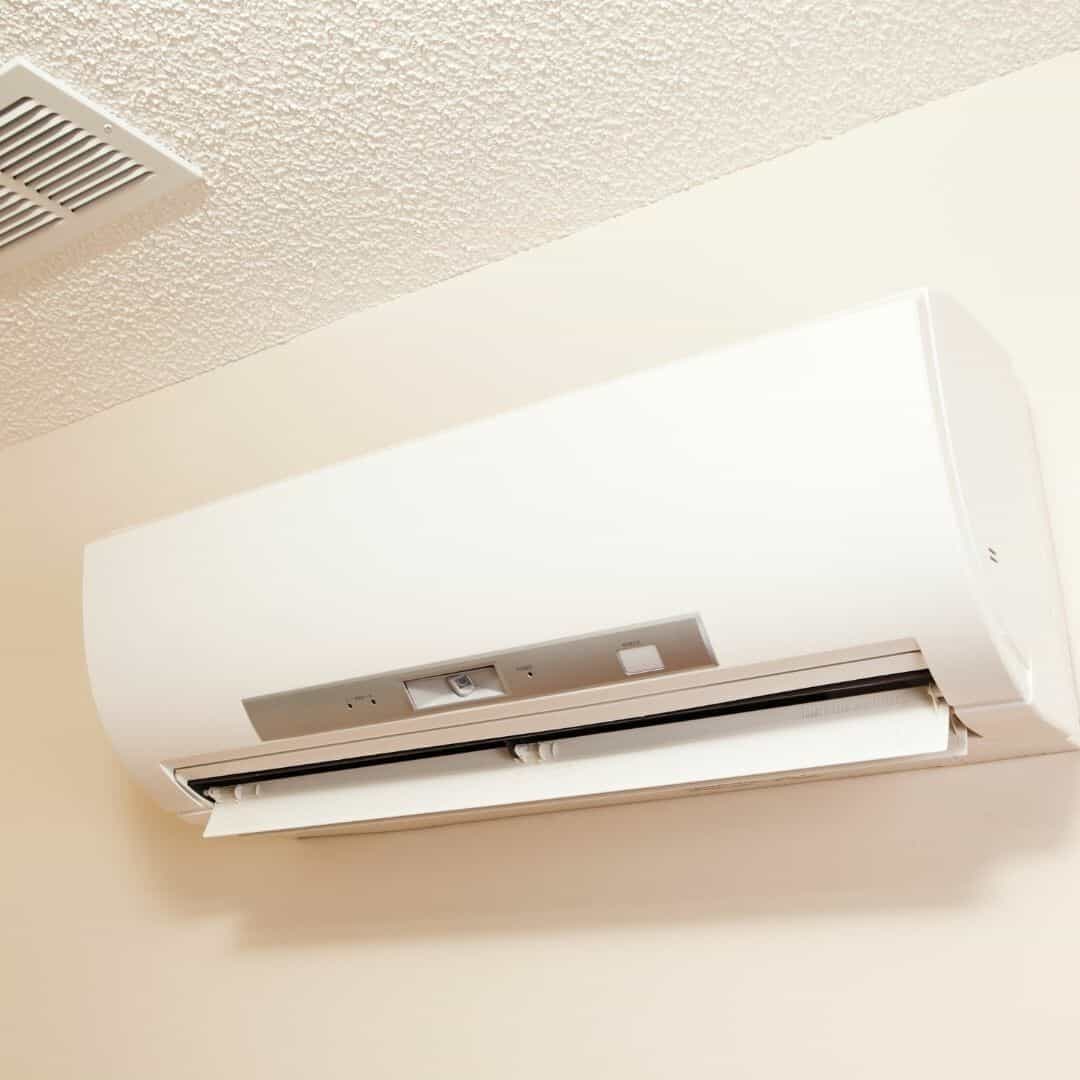How Many Amps Does An Air Conditioner Use? (Calculation & Tips)

As the summer is fast approaching, many people will be looking to turn on their air conditioning units. But before you switch on your AC unit, you must know exactly how many amps the air conditioner is using.
Not knowing the number of amps used by the air conditioner could lead to heavy electrical bills. Worse still, it may cause power overload, potentially shutting down your neighborhood!
So, Before switching on that new AC unit for the first time, ensure you understand its amp usage!
In this article, we will look at how to calculate how many amps an air conditioner uses and select the best AC unit for your home.
How Many Amps Does an AC Unit Draw?
The capacity of an air conditioning system is typically described in the owner’s manual using BTU, EER, and Voltage ratings. While the amperes rating is not usually listed on the label, it is one of the most important factors to consider when selecting an air conditioner for your home.
The amps rating of an air conditioner indicates how much current it draws and the amount of electricity that flows through it in an hour.
Different air conditioner brands provide varying levels of amp usage. However, the average amp usage for air conditioners is 1 amp per 500 BTU. But, other factors, such as the EER (Energy Efficiency Ratio) and voltage rating, are also taken into account when determining how many amps an AC unit will draw.
The table below shows the average amperage requirements of various AC units on the market today.
| Air Conditioner Capacity (BTU) | EER | Volts | Amps |
| 5,000 BTU | 10 | 115v | 4.35 Amp |
| 6,000 BTU | 10 | 115v | 5.22 Amp |
| 8,000 BTU | 10 | 115v | 6.96 Amp |
| 10,000 BTU | 10 | 115v | 8.70 Amp |
| 12,000 BTU | 10 | 115v | 10.43 Amp |
| 14,000 BTU | 10 | 115v | 12.17 Amp |
| 15,000 BTU | 10 | 115v | 13.04 Amp |
How To Calculate Amps Usage of an Air Conditioner?

To understand the above chart, the following guide is essential to calculate the amp rating of an air conditioner.
Step 1: Identify the BTU Rating
An air conditioner’s BTU (British Thermal Unit) rating indicates how much heat it can remove from a room at a time. The higher the BTU units, the better the cooling supply of an AC unit in a larger space.
Check the label on the side or back of the AC condensing unit to find out how many BTUs your air conditioner has. Sizes can range from 5000 to 28 000 BTU. However, some air conditioners describe their capacity using Tons. Note that 1 ton equals 12,000 BTU.
Step 2: Identify the EER Rating
The Energy-Efficiency Ratio (EER) is a measure of the efficiency of an air conditioner when it uses electricity to cool a space. The EER rating can be found on the same label or tag as the BTU (British Thermal Unit) rating and typically ranges from 13 to 25.
A higher EER rating means that the air conditioner will use less energy, which can result in lower energy bills and a smaller carbon footprint.
Step 3: Identify the Voltage Capacity
The voltage rating measures the flow of electric current between two points. A higher voltage system can move electric current faster over the connection. Depending on the size and model of the unit, the voltage of an air conditioner can range between 100V and 280V.
To determine the voltage of your AC unit, check the label on the outside of the condensing unit. If the voltage is not specified, the volt rating can still be determined using the BTU. A 5000 BTU will typically have 120V. Most central air conditioners are 230 volts.

Step 4: Covert BTU and EER Ratings to Wattage
To get the wattage rating of your AC unit, divide the BTU rating by the EER rating.
In other words, Wattage = BTU/EER.
For example, if an air conditioner has a BTU rating of 15,000 and an EER rating of 16.
Wattage = 15,000/16.
= 937.5 watts
Step 5: Convert Watts and Volts to Amps.
To determine the amp usage of your air conditioner, divide the wattage by the volt rating.
In other words, Amps = Wattage/Volts.
For example, if an air conditioner has 5000 BTUs, a 13 EER rating, and a voltage of 120V,
Amps = 937.5 /120.
= 8 amps
If the rigors of calculating amp usage are not what you can undertake, simply use an online amps calculator to determine the amp usage of your air conditioner. And for more information on how to calculate the amps usage of an air conditioner, watch the video below.
Now that you know how to calculate the amp usage of a central air conditioner let’s look at the amp usage of various air conditioner models.
How Many Amps Does a Central Air Conditioner Use?
The central ac unit is the most common system in most homes. There are two varieties. A full package system with one unit and a split air system with indoor and outdoor units. The central air conditioner is efficient in cooling a large house with multiple rooms.
Depending on the model and size, a central air conditioner can consume between 15 and 20 amps.
How Many Amps Does a Mini-Split Air Conditioner Use?
The mini-split air conditioner is another popular system in homes and offices. It is a smaller air conditioner, also known as a ductless AC. A mini-split AC still has an outdoor condenser but can have several indoor units to serve multiple rooms in a house. A small 110v unit mini-split AC will typically draw 5 amps.
How Many Amps Does a Window Air Conditioner Use?
Window ac units are ideal for cooling off small to medium-sized rooms, measuring up to 550 square feet. They come with a BTU rating between 5,000 and 12,000 and operate on a voltage rating between 115 and 220V.
These air conditioners usually require more amps than other types of air conditioners. Depending on BTU capacity, a window AC can draw between 4 and 20 amps.
How Many Amps Does a Portable Air Conditioner Use?
A portable ac unit is an energy-efficient unit that works best in small spaces. This AC unit has the advantage of being able to be placed anywhere in your home or office. Portable air conditioners typically consume between 3 and 10 amps.

How to Choose an AC Unit for Your Home and Cut Down Electricity Bill?
Is your air conditioner drawing so many amps that it’s costing you a fortune in utility bills every month? Or do you want the best air conditioning unit for your home with the least amount of maintenance? Consider the following factors when shopping for a new air conditioner.
1. Invest in an Energy-Efficient AC Unit
The higher the energy efficiency of an air conditioner, the lower the amps drawn by the unit. So, when buying air conditioners, I recommend that you look for those with a higher EER rating. They draw fewer amps and consume less electricity, saving you money on your utility bill.
Also, keep in mind that the higher the BTU rating of the air conditioner, the more amps it will require. As a result, do not install a high-BTU air conditioner in a small space.
2. Consider the Size of Your Space
The size of the air conditioner should be proportional to the amount of space available in your home. Installing an AC unit that is too large for your space will result in higher electric bills. For example, if your room is about 150 square feet, a 5000 BTU air conditioner is sufficient to keep it cool.
Similarly, installing an AC unit that is too small for your space will force it to work harder, thus causing increased electricity consumption.
3. Connect Your AC Unit to the Right Circuit Breaker
Do not use an air conditioner with a higher amp rating than your home’s circuit breakers. If necessary, install a dedicated circuit breaker for the unit.
For example, if your air conditioner draws more than 15 amps of current, install a dedicated 220-volt circuit breaker for your air conditioner. Also, make sure to hire a professional for any HVAC or electrical installation.
4. Automate Your Home with a Smart AC Unit
The best way to save energy in your home is to choose an air conditioning system that uses advanced technology. This includes a WiFi-enabled air conditioner, an air conditioner with auto-turning on and off features, and an air conditioner with automated temperature control.
Conclusion
Knowing how many amps an air conditioner draws not only saves you money on utility and maintenance but it also assists you in choosing the best AC unit for your home.
Here are the key takeaways from this article:
- An AC’s amps usage is calculated by converting BTU and EER to wattage, then wattage and voltage to amps.
- The higher the BTU rating of an AC system, the more amps it uses.
- The higher the EER rating of an air conditioner, the fewer amps it will use.
- Your air conditioner’s electricity usage will depend upon the unit’s size, the year’s season, and the number of people in your house.
I hope you found this guide useful in determining the number of amps you need for your AC unit. Let’s hear your thoughts in the comment section.









